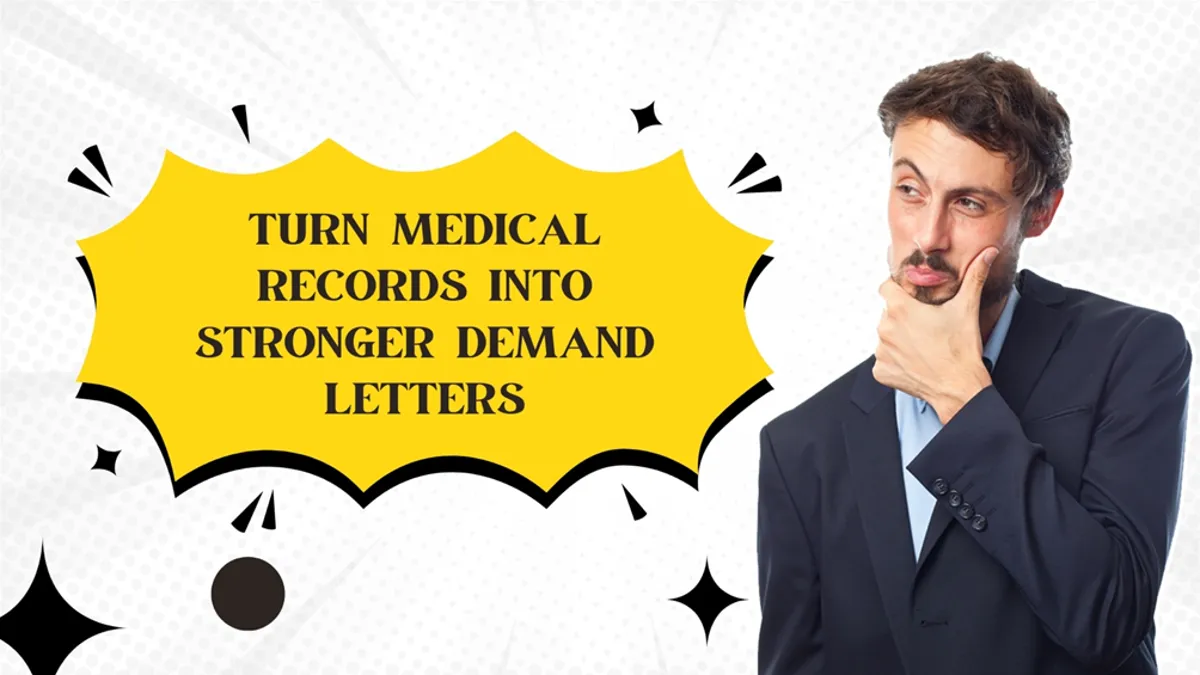If you’ve ever drafted a demand letter, you know it’s more than just a formal request for compensation. It’s your client’s story, backed by facts and numbers and nothing supports that story better than well-organized, clearly presented medical records.
However, the challenge is – medical records are often messy, overwhelming, and filled with jargon. So how do you turn those complex records into clear, compelling content for your demand letter?
Let’s walk through it.
Why medical records matter
At the heart of every injury claim is the proof of injury, treatment, and impact, which is hidden in medical records. These documents aren’t just supporting material. They’re the foundation of your demand letters.
Strong medical records can:
- Justify your compensation demand
- Support the timeline of events
- Demonstrate the seriousness of injuries
- Show ongoing or future medical needs
In short, they help the other side understand why your client’s claim deserves attention and payment.
The Problem: Voluminous and complex medical records
You may be handed hundreds of pages, often out of order, with duplicate entries and hard-to-read notes. Trying to pull out key facts from that stack is time-consuming and exhausting.
When you sift through this mess, you might get miss important details, and your demand letter may end up too vague or incomplete to make an impact.
The Solution: Simplify and summarize
The key is to turn raw records into a clean, readable summary that supports your demand.
Here’s how to do it:
1. Organize the records
Start by sorting records chronologically. Identify and remove duplicates, and ensure you have everything, ER reports, imaging, specialist visits, therapy notes, bills, etc.
2. Create a medical summary
- A clear medical summary should include:
- Date of injury and treatment timeline
- Diagnoses and procedures
- Medications and therapies
- Work impact (e.g., days missed, restrictions)
- Prognosis or permanent impairment (if applicable)
A timeline format or table can help make the information easy to digest.
3. Highlight key evidence
Use this summary to pinpoint the facts that matter for your settlement demand letter, especially those that show the severity, duration, and financial impact of the injury.
Example:
“Following the accident on March 5, 2025, the client was diagnosed with a torn ACL, underwent surgery on April 12, 2025, and completed 10 weeks of physical therapy. Due to mobility limitations, the client missed 6 weeks of work, resulting in $6,000 in lost wages.”
Pro tip: Use visuals and attachments
Don’t just write about the injury, show it.
- Include exhibits (medical bills, doctor’s notes, wage statements)
- Use bullet points or tables for clarity
- Attach a medical chronology or summary as part of the demand package
This approach makes your demand letter more professional, persuasive, and easy to understand.
Save time with technology
Manual review is possible, but it’s not always efficient.
Many legal teams now use AI tools to review and summarize medical records quickly. These tools can flag key data, organize timelines, and even calculate economic damages.
Whether you do it manually or with tech support, the goal is the same, that is turning medical chaos into a clear case. Try some AI demand letter services to know the difference.
The payoff: A demand letter that works
When you use medical records effectively, your personal injury demand letter becomes stronger, sharper, and more convincing.
You’re not just saying your client suffered, but you’re proving it with facts.
In a world where adjusters and defense attorneys see hundreds of claims, precision and clarity help your demand stand out.
To wrap up,
Next time you sit down to draft a demand letter, remember, your client’s medical records are more than just paperwork. They’re the key to telling a compelling story that gets results.
Take the time to use them well, and you’ll see the difference, in how your letters are received, and in the outcomes you achieve.
If you find the task of writing demand letters too complex, outsource the task to professional demand letter services like LezDo TechMed.

